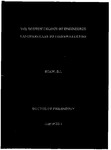THE ECOTOXICOLOGY OF ENGINEERED NANOPARTICLES TO FRESHWATER FISH
| dc.contributor.supervisor | Handy, Richard | |
| dc.contributor.author | Shaw, Benjamin John | |
| dc.contributor.other | Faculty of Science and Engineering | en_US |
| dc.date.accessioned | 2011-09-16T08:53:41Z | |
| dc.date.available | 2011-09-16T08:53:41Z | |
| dc.date.issued | 2011 | |
| dc.identifier | 706578 | en_US |
| dc.identifier.uri | http://hdl.handle.net/10026.1/565 | |
| dc.description.abstract |
The use of nanoscale materials is growing exponentially, but there are also concerns about the environmental hazard to aquatic biota. Metal-containing engineered nanoparticles (NPs) are an important group of these new materials, and whilst there are undoubtedly a plethora of beneficial uses for these NPs, it is essential that an appropriate risk assessment is carried out in order to protect the environment and human health, with the consumption of contaminated fish a distinct possibility. The current study aimed to assess the bioavailability, uptake and toxicological effects of two metal-NPs (TiO2 NPs and Cu-NPs) to fish from both dietary and waterborne exposure routes and where appropriate compare them to their bulk counterpart. Whole body system effects were assessed along with the influences of the life stage of exposed fish and abiotic factors on toxicity. A technique to improve the quantification of Ti from TiO2 NPs in fish tissue was also developed. Effects from exposure to dietary TiO2 NPs manifested similarly to traditional dietary metal exposure, with no reduction in growth, but some sublethal affects. Exposure to waterborne Cu-NPs showed that rainbow trout were more acutely sensitive to CuSO4 than the NPs, but that despite limited uptake several body systems were affected (most notably ionoregulation). Larvae were more sensitive to CuSO4 than Cu-NPs, but no differences were seen with embryos, whilst larvae were more sensitive than embryos. Abiotic factors did have an effect on acute Cu-NP toxicity, though not always in a predictable manner, with some effects more pronounced than with CuSO4. Overall, it appears that metal-NPs are not as acutely toxic as their bulk counterparts, but sublethal effects, were routinely observed. As TiO2 NPs appear more toxic than its bulk counterpart, current legislation governing safe environmental limits may have to be adjusted, though the situation with Cu-NPs isn’t as clear and further investigation is required. However, the risk of human exposure via the consumption of NP contaminated fish fillets is extremely low. | en_US |
| dc.language.iso | en | en_US |
| dc.publisher | University of Plymouth | en_US |
| dc.subject | Nanoparticles | en_US |
| dc.subject | Toxicity | en_US |
| dc.subject | Fish | en_US |
| dc.subject | Waterborne | en_US |
| dc.subject | Dietary | en_US |
| dc.subject | TiO2 | en_US |
| dc.subject | Copper | en_US |
| dc.subject | Abiotic factors | en_US |
| dc.title | THE ECOTOXICOLOGY OF ENGINEERED NANOPARTICLES TO FRESHWATER FISH | en_US |
| dc.type | Thesis | |
| dc.identifier.doi | http://dx.doi.org/10.24382/4809 |
Files in this item
This item appears in the following Collection(s)
-
01 Research Theses Main Collection
Research Theses Main


